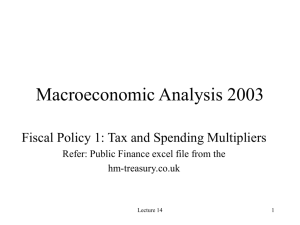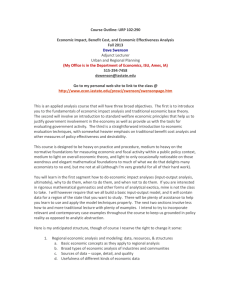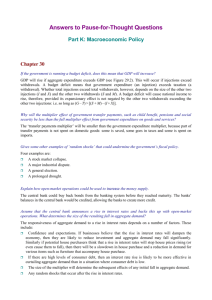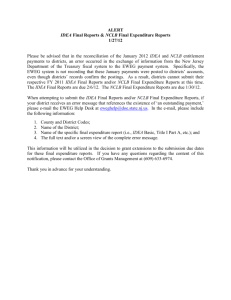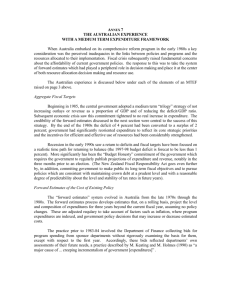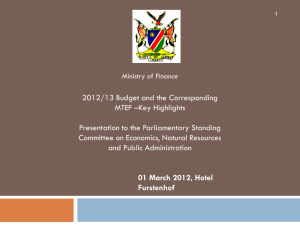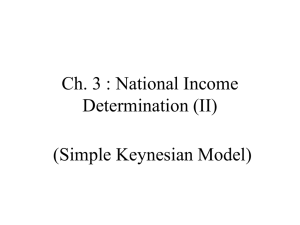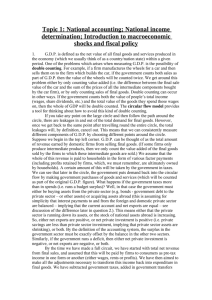Answers to Questions in Chapter 17
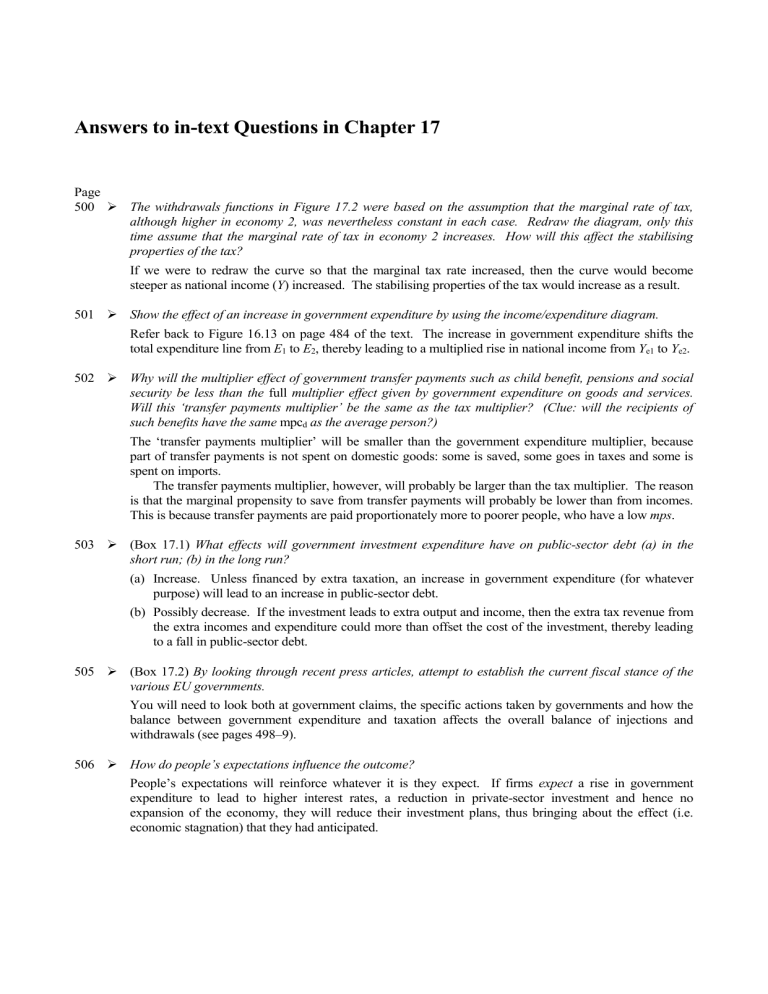
Answers to in-text Questions in Chapter 17
Page
500 The withdrawals functions in Figure 17.2 were based on the assumption that the marginal rate of tax, although higher in economy 2, was nevertheless constant in each case. Redraw the diagram, only this time assume that the marginal rate of tax in economy 2 increases. How will this affect the stabilising properties of the tax?
If we were to redraw the curve so that the marginal tax rate increased, then the curve would become steeper as national income ( Y ) increased. The stabilising properties of the tax would increase as a result.
501 Show the effect of an increase in government expenditure by using the income/expenditure diagram.
Refer back to Figure 16.13 on page 484 of the text. The increase in government expenditure shifts the total expenditure line from E
1
to E
2
, thereby leading to a multiplied rise in national income from Y e1
to Y e2
.
502
Why will the multiplier effect of government transfer payments such as child benefit, pensions and social security be less than the full multiplier effect given by government expenditure on goods and services.
Will this ‘transfer payments multiplier’ be the same as the tax multiplier? (Clue: will the recipients of such benefits have the same mpc d
as the average person?)
The ‘transfer payments multiplier’ will be smaller than the government expenditure multiplier, because part of transfer payments is not spent on domestic goods: some is saved, some goes in taxes and some is spent on imports.
The transfer payments multiplier, however, will probably be larger than the tax multiplier. The reason is that the marginal propensity to save from transfer payments will probably be lower than from incomes.
This is because transfer payments are paid proportionately more to poorer people, who have a low mps .
503
(Box 17.1) What effects will government investment expenditure have on public-sector debt (a) in the short run; (b) in the long run?
(a) Increase. Unless financed by extra taxation, an increase in government expenditure (for whatever purpose) will lead to an increase in public-sector debt.
(b) Possibly decrease. If the investment leads to extra output and income, then the extra tax revenue from the extra incomes and expenditure could more than offset the cost of the investment, thereby leading to a fall in public-sector debt.
505
(Box 17.2) By looking through recent press articles, attempt to establish the current fiscal stance of the various EU governments.
You will need to look both at government claims, the specific actions taken by governments and how the balance between government expenditure and taxation affects the overall balance of injections and withdrawals (see pages 498–9).
506
How do people’s expectations influence the outcome?
People’s expectations will reinforce whatever it is they expect. If firms expect a rise in government expenditure to lead to higher interest rates, a reduction in private-sector investment and hence no expansion of the economy, they will reduce their investment plans, thus bringing about the effect (i.e. economic stagnation) that they had anticipated.
Answers to questions in Economics (4th edition) by John Sloman
Page
506
Do theories of the long-run and short-run consumption functions help us to understand consumer reactions to a change in taxes?
If consumption is less responsive to changes in disposable income in the short run than in the long run, then tax changes will have less effect on consumption (and hence a smaller multiplier effect) in the short run than in the long run.
507
(Box 17.3) If tax cuts are largely saved, should an expansionary fiscal policy be confined to increases in government spending?
Under these conditions, increases in government spending, provided they are direct expenditure on outputgenerating activities, will be more effective than tax cuts in stimulating a recovery.
Give some examples of these random shocks.
Changes in international (and hence national) interest rates; a war in the Middle East and hence a sudden rise in oil prices; a crisis in Asia or in the US economy, which pushes the world into recession; an unpredictable rise in industrial disputes; a political crisis at home.
509
(Box 17.4) 1. Could you drive the car at a steady speed if you knew that all the hills were the same length and height and if there were a constant 30-second delay on the pedals?
Yes. You would simply push on the accelerator (or brake) 30 seconds before you wanted the effect to occur. You would do this so that the car would end up braking as you went down hill and accelerating as you went up hill.
The lesson for fiscal policy is that if forecasting is correct, if you know the precise effects of any fiscal measures, and if there are no random shocks, then fiscal policy can stabilise the economy.
(Box 17.4) 2. What would a fixed throttle approach to fiscal policy involve?
It could either involve setting targets for the PSBR (or PSDR) or budget deficit (or surplus), which would be stuck to, irrespective of what happened to the economy. The problem with this is that it would remove any automatic stabilising effects of fiscal policy.
An alternative is to set targets for the PSBR (or PSDR) or budget deficit (or surplus) that vary with the level of unemployment, or some other measure of the degree of slack in the economy. Thus the greater the slack, the bigger would be the target deficit. This would then build in an automatic stabilising element.
The more the economy expanded, and slack was taken up, the more the deficit would be reduced (or surplus increased), thereby dampening the growth in aggregate demand.
2


